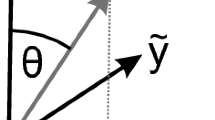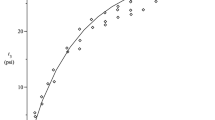Abstract
FROM the time of the publication of the “Lehrbuch der Kristallphysik”1 until 1951 there was no challenge to the classical theory of the elastic properties of crystals. At the Solvay Conference of that year, Laval2 published an account of a theory which rejected some of the fundamental assumptions made in classical theory. Further work leading to the same conclusions was published later by Le Corre3, Viswanathan4, Raman5 and Krishnamurti6. In non-mathematical language the difference between the old and new theories may be expressed as follows. On the classical theory, the equilibrium of a cube within a body at rest, which is subjected to any given set of mechanical stresses, is maintained solely by the forces acting normally or tangentially to its surfaces. If one edge of the cube is supposed vertical then tangential forces act on the vertical faces and, in equilibrium, the couples due to the tangential shear stresses acting on these faces just balance. The new theory denies the adequacy of this statement and asserts that ‘volume-couples’ can exist which must be balanced by the difference between the couples which were assumed to be equal and opposite in the old theory. In more formal language, the old theory asserts that the stress tensor is symmetric while the new theory asserts that it is in general non-symmetric. A corresponding difference exists in the treatment of the deformation experienced by the cube. The old theory assumes that all net rotations of the whole body may be regarded as irrelevant, so far as its elastic deformation is concerned. The new theory denies this and asserts that the deformation can only be adequately described by taking into account any net rotation which may be caused by the stresses. More formally, the ol d theory assumes a symmetric and the new theory a non-symmetric tensor for the strain. One of the consequences of the new theory is that the number of elastic constants is increased, for example, in the triclinic system from twenty-one on Voigt's theory to forty-five on the new theory.
This is a preview of subscription content, access via your institution
Access options
Subscribe to this journal
Receive 51 print issues and online access
$199.00 per year
only $3.90 per issue
Buy this article
- Purchase on Springer Link
- Instant access to full article PDF
Prices may be subject to local taxes which are calculated during checkout
Similar content being viewed by others
References
Voigt, W., “Lehrbuch der Kristallphysik” (Teubner, Leipzig, 1910).
Laval, J., “L'état solide”, Rapports et Discussions, Congrès Solvay, 1951 (Stoops, Bruxelles).
Le Corre, Y., Bull. Soc. Franc. Minér. Crist., 76, 464 (1953); 77, 1363 and 1393 (1954) ; 78, 33 (1955).
Viswanathan, K. S., Proc. Ind. Acad. Sci., A, 39, 196 (1954) ; 41, 98 (1955).
Raman, C. V., and Viswanathan, K. S., Proc. Ind. Acad. Sci., A, 42, 1 and 51 (1955).
Raman, C. V., and Krishnamurti, D., Proc. Ind. Acad. Sci., A, 42, 111 (1955).
Zubov, V. G., and Firsova, M. M., Kristallographia, 1, 546 (1956).
Author information
Authors and Affiliations
Rights and permissions
About this article
Cite this article
JOEL, N., WOOSTER, W. Theories of Crystal Elasticity. Nature 180, 430–431 (1957). https://doi.org/10.1038/180430a0
Issue Date:
DOI: https://doi.org/10.1038/180430a0
This article is cited by
-
Number of Elastic Constants required in Crystal Elasticity
Nature (1958)
-
Interface Couples in Crystals
Nature (1958)
Comments
By submitting a comment you agree to abide by our Terms and Community Guidelines. If you find something abusive or that does not comply with our terms or guidelines please flag it as inappropriate.



